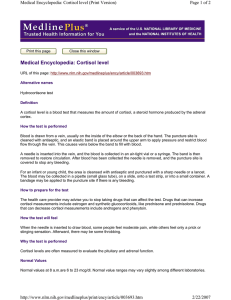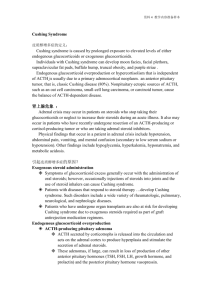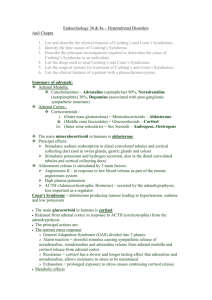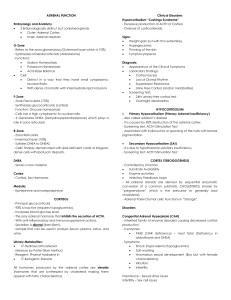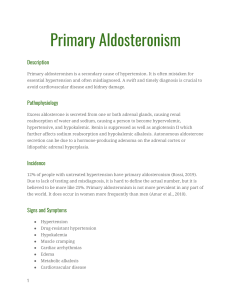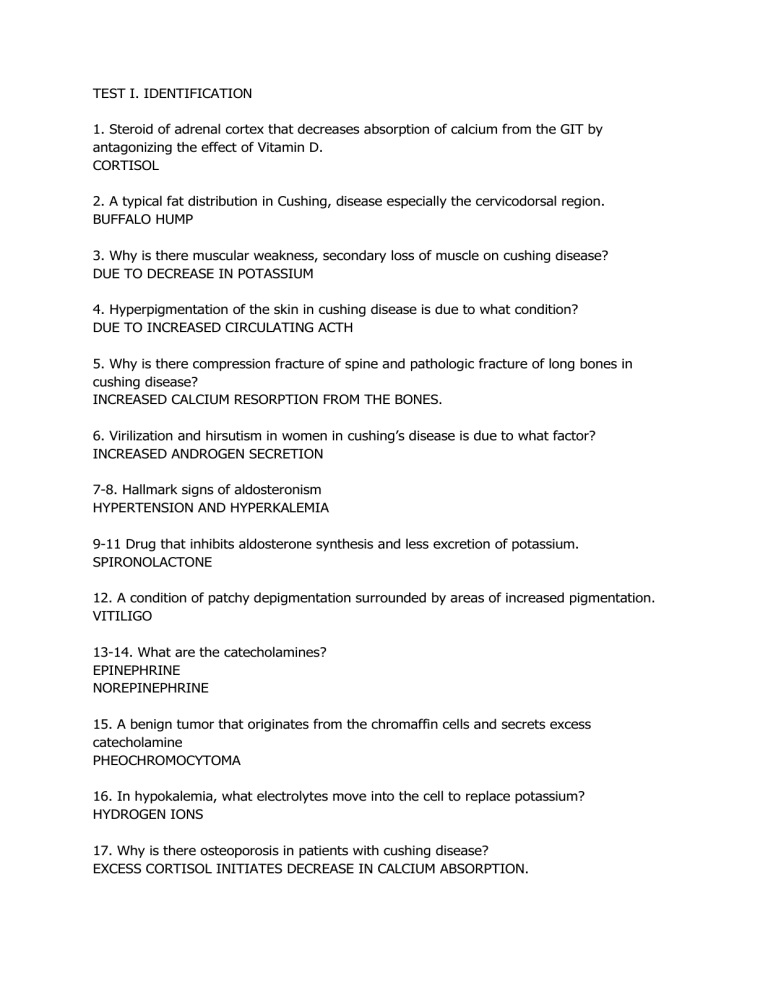
TEST I. IDENTIFICATION 1. Steroid of adrenal cortex that decreases absorption of calcium from the GIT by antagonizing the effect of Vitamin D. CORTISOL 2. A typical fat distribution in Cushing, disease especially the cervicodorsal region. BUFFALO HUMP 3. Why is there muscular weakness, secondary loss of muscle on cushing disease? DUE TO DECREASE IN POTASSIUM 4. Hyperpigmentation of the skin in cushing disease is due to what condition? DUE TO INCREASED CIRCULATING ACTH 5. Why is there compression fracture of spine and pathologic fracture of long bones in cushing disease? INCREASED CALCIUM RESORPTION FROM THE BONES. 6. Virilization and hirsutism in women in cushing’s disease is due to what factor? INCREASED ANDROGEN SECRETION 7-8. Hallmark signs of aldosteronism HYPERTENSION AND HYPERKALEMIA 9-11 Drug that inhibits aldosterone synthesis and less excretion of potassium. SPIRONOLACTONE 12. A condition of patchy depigmentation surrounded by areas of increased pigmentation. VITILIGO 13-14. What are the catecholamines? EPINEPHRINE NOREPINEPHRINE 15. A benign tumor that originates from the chromaffin cells and secrets excess catecholamine PHEOCHROMOCYTOMA 16. In hypokalemia, what electrolytes move into the cell to replace potassium? HYDROGEN IONS 17. Why is there osteoporosis in patients with cushing disease? EXCESS CORTISOL INITIATES DECREASE IN CALCIUM ABSORPTION. 18. Why would hypokalemia in aldosteronism bad to muscular weakness and cardiac arrhythmias ALTERATION IN NEUROMUSCULAR ACTIVITY 19. Who first described adrenal insufficiency disorder? THOMAS ADDISON 20, This may occur from excessive glucocorticoid use because the protein matrix in the bones is broken down thus cannot retain calcium. OSTEOPOROSIS 21. Virilization syndrome that results from excessive production of adrenal androgens. ADRENOGENITAL SYNDROME 22) Endogenous secondary adrenal insufficiency caused by postpartum pituitary infarction. SHEEHAN’S SYNDROME 23) What adrenal insufficiency is manifested by profound fatigue, hypertension, dehydration, vascular collapse, renal shutdown and decreased serum sodium, neurologic deficit? ADRENAL CRISIS 24.-25 What is secreted in the posterior pituitary gland? OXYTOCIN VASOPRESSIN 26. Pituitary disorder in children characterized by stunted growth. DWARFISM 27. Decrease production of all the anterior pituitary hormones. PANHYPOPITUITARISM 78. Atrophy of the extremities of the body. ACROMICRIA 29. Anterior pituitary disorder characterized by enlargement thickening and broadening of and extremities of the body. ACROMEGALY 30. Anterior name for the acromegalic face. GORILLA FACE TEST II. COLUMN A. 1. 2. 3. 4. 5. 6. 7. 8. Zona fasciculata Aldosterone Mobilization of fat from fat depots to supply energy. Hyperfunction of Adrenal cortex Caused by over secretion of aldosterone Caused by diuretics, renal failure, renin-secreting tumor. Leads to muscular weakness and cardiac arrhythmias. Due to metabolic alkalosis which reduces the amount of ionized calcium in the plasma. 9. May result in ascending paralysis, flaccid quadriplegia and mixed sensory deficit. 10. Due to absence of cortisol. 11. Due to high circulating level of ACTH 12. Lethargy, weight loss, postural hypothension, hyperpigmentation and hypoglycemia are symptoms of what condition, 13. 20% is caused by tuberculosis 14. Primary aldosteronism 15. Enlarged clitoris, labial fusion urethral opening at its base 16. Hyponatremia, decreased renal output, dyspnea, fatigue, increased body weight due to ADH dysfunction. COLUMN B A. B. C. D. E. F. G. H. I. J. K. L. M. N. O. P. Q. R. Lipolytic Ketogenic Decreased Potassium Hypoglycemia Glucocorticoid Catecholamines CONN's Syndrome Mineralocorticoid Hyperkalemia SIADH Cushing Syndrome Hyperpigmentation Secondary Aldosteronism Hyponatremia Tetany Female Pseudohermaphroditism Addison's Disease Hyperglycemia TEST III 1. Secretes mineralocorticoid a. Zone reticularis b. Zona fasciculata c. Zona glomerulosa 2. Play a major role in protein and lipid metabolism a. Mineralocorticoid b. Glucocorticoid c. Androgen 3. Anti-stress and anti-shock effects, and anti-inflammatory effect a. Cortisol b. Aldosterone C. Androgen 4. Increases absorption of Na+, excretion of potassium and acts as a long term regulation of blood pressure. a. Cortisol b. Androgen C. Aldosterone 5. What is not included in cushing disease. a. Hyperkalemia b. Hypertension c. Hyperglycemia d. Hypernatremia 6. Cardiovascular collapse, shock-like syndrome, seizure, low BP, Hypoglycemia, Confusion,neurologic deficits. a. Cushing syndrome b. Addison's disease C. Adrenal crisis 7. What is not included in the clinical manifestations of Pheochromocytoma. a. Hypernatremia b. Hyperglycemia c. Hypermetabolism d. Hyperhidrosis 8. Secretes glucocorticoid a. Zona fasciculata b. Zona reticularis c. Zona glomerulosa 9. Inhibits allergic responses and increase blood glucose level a. Androgen b. Aldosterone c. Córtisol 10. Most common test used to diagnose cushing disease Except: a. Fasting blood sugar b. Low-dose dexamethasone suppression c. Midnight plasma cortisol test d. 24 hours' urine free cortisol test

